Come posso cambiare il colore dei punti di impaginazione di UIPageControl?
Risposte:
AGGIORNARE:
Questa risposta ha 6 anni ed è molto obsoleta, ma sta ancora attirando voti e commenti. Da iOS 6.0 dovresti usare le proprietà pageIndicatorTintColore currentPageIndicatorTintColorsu UIPageControl.
RISPOSTA ORIGINALE:
Ho riscontrato questo problema oggi e ho deciso di scrivere la mia semplice classe di sostituzione.
È una UIView sottoclasse che utilizza Core Graphics per eseguire il rendering dei punti nei colori specificati.
Utilizzare le proprietà esposte per personalizzarlo e controllarlo.
Se lo desideri, puoi registrare un oggetto delegato per ricevere notifiche quando l'utente tocca uno dei piccoli punti della pagina. Se nessun delegato è registrato, la vista non reagirà all'input tattile.
È completamente fresco dal forno, ma sembra funzionare. Fammi sapere se riscontri problemi.
Miglioramenti futuri:
- Ridimensiona i punti per adattarli ai limiti attuali se ce ne sono troppi.
- Non ridisegnare l'intera vista in drawRect:
Esempio di utilizzo:
CGRect f = CGRectMake(0, 0, 320, 20);
PageControl *pageControl = [[[PageControl alloc] initWithFrame:f] autorelease];
pageControl.numberOfPages = 10;
pageControl.currentPage = 5;
pageControl.delegate = self;
[self addSubview:pageControl];
File di intestazione:
//
// PageControl.h
//
// Replacement for UIPageControl because that one only supports white dots.
//
// Created by Morten Heiberg <morten@heiberg.net> on November 1, 2010.
//
#import <UIKit/UIKit.h>
@protocol PageControlDelegate;
@interface PageControl : UIView
{
@private
NSInteger _currentPage;
NSInteger _numberOfPages;
UIColor *dotColorCurrentPage;
UIColor *dotColorOtherPage;
NSObject<PageControlDelegate> *delegate;
//If ARC use __unsafe_unretained id delegate;
}
// Set these to control the PageControl.
@property (nonatomic) NSInteger currentPage;
@property (nonatomic) NSInteger numberOfPages;
// Customize these as well as the backgroundColor property.
@property (nonatomic, retain) UIColor *dotColorCurrentPage;
@property (nonatomic, retain) UIColor *dotColorOtherPage;
// Optional delegate for callbacks when user taps a page dot.
@property (nonatomic, retain) NSObject<PageControlDelegate> *delegate;
@end
@protocol PageControlDelegate<NSObject>
@optional
- (void)pageControlPageDidChange:(PageControl *)pageControl;
@end
File di implementazione:
//
// PageControl.m
//
// Replacement for UIPageControl because that one only supports white dots.
//
// Created by Morten Heiberg <morten@heiberg.net> on November 1, 2010.
//
#import "PageControl.h"
// Tweak these or make them dynamic.
#define kDotDiameter 7.0
#define kDotSpacer 7.0
@implementation PageControl
@synthesize dotColorCurrentPage;
@synthesize dotColorOtherPage;
@synthesize delegate;
- (NSInteger)currentPage
{
return _currentPage;
}
- (void)setCurrentPage:(NSInteger)page
{
_currentPage = MIN(MAX(0, page), _numberOfPages-1);
[self setNeedsDisplay];
}
- (NSInteger)numberOfPages
{
return _numberOfPages;
}
- (void)setNumberOfPages:(NSInteger)pages
{
_numberOfPages = MAX(0, pages);
_currentPage = MIN(MAX(0, _currentPage), _numberOfPages-1);
[self setNeedsDisplay];
}
- (id)initWithFrame:(CGRect)frame
{
if ((self = [super initWithFrame:frame]))
{
// Default colors.
self.backgroundColor = [UIColor clearColor];
self.dotColorCurrentPage = [UIColor blackColor];
self.dotColorOtherPage = [UIColor lightGrayColor];
UISwipeGestureRecognizer *swipeRight = [[UISwipeGestureRecognizer alloc] initWithTarget:self action:@selector(swipedRight:)];
[swipeRight setDirection:UISwipeGestureRecognizerDirectionRight];
[self addGestureRecognizer:swipeRight];
UISwipeGestureRecognizer *swipe = [[UISwipeGestureRecognizer alloc] initWithTarget:self action:@selector(swipedLeft:)];
[swipe setDirection:UISwipeGestureRecognizerDirectionLeft];
[self addGestureRecognizer:swipe];
}
return self;
}
-(void) swipedLeft:(UISwipeGestureRecognizer *) recognizer
{
self.currentPage++;
}
-(void) swipedRight:(UISwipeGestureRecognizer *) recognizer
{
self.currentPage--;
}
- (void)drawRect:(CGRect)rect
{
CGContextRef context = UIGraphicsGetCurrentContext();
CGContextSetAllowsAntialiasing(context, true);
CGRect currentBounds = self.bounds;
CGFloat dotsWidth = self.numberOfPages*kDotDiameter + MAX(0, self.numberOfPages-1)*kDotSpacer;
CGFloat x = CGRectGetMidX(currentBounds)-dotsWidth/2;
CGFloat y = CGRectGetMidY(currentBounds)-kDotDiameter/2;
for (int i=0; i<_numberOfPages; i++)
{
CGRect circleRect = CGRectMake(x, y, kDotDiameter, kDotDiameter);
if (i == _currentPage)
{
CGContextSetFillColorWithColor(context, self.dotColorCurrentPage.CGColor);
}
else
{
CGContextSetFillColorWithColor(context, self.dotColorOtherPage.CGColor);
}
CGContextFillEllipseInRect(context, circleRect);
x += kDotDiameter + kDotSpacer;
}
}
- (void)dealloc
{
[dotColorCurrentPage release];
[dotColorOtherPage release];
[delegate release];
[super dealloc];
}
- (void)touchesBegan:(NSSet *)touches withEvent:(UIEvent *)event
{
if (!self.delegate) return;
CGPoint touchPoint = [[[event touchesForView:self] anyObject] locationInView:self];
CGFloat dotSpanX = self.numberOfPages*(kDotDiameter + kDotSpacer);
CGFloat dotSpanY = kDotDiameter + kDotSpacer;
CGRect currentBounds = self.bounds;
CGFloat x = touchPoint.x + dotSpanX/2 - CGRectGetMidX(currentBounds);
CGFloat y = touchPoint.y + dotSpanY/2 - CGRectGetMidY(currentBounds);
if ((x<0) || (x>dotSpanX) || (y<0) || (y>dotSpanY)) return;
self.currentPage = floor(x/(kDotDiameter+kDotSpacer));
if ([self.delegate respondsToSelector:@selector(pageControlPageDidChange:)])
{
[self.delegate pageControlPageDidChange:self];
}
}
@end
In iOS 6 puoi impostare il colore della tinta di UIPageControl:
Ci sono 2 nuove proprietà:
pageIndicatorTintColorcurrentPageIndicatorTintColor
Puoi anche utilizzare l'API dell'aspetto per modificare il colore della tinta di tutti gli indicatori di pagina.
Se scegli come target iOS 5 assicurati che non si blocchi:
if ([pageControl respondsToSelector:@selector(setPageIndicatorTintColor:)]) {
pageControl.pageIndicatorTintColor = [UIColor whiteColor];
}
pageControl.pageIndicatorTintColor = [UIColor redColor];
pageControl.currentPageIndicatorTintColor = [UIColor redColor];
funziona per iOS6
Nel caso in cui qualcuno desideri una versione ARC / moderna (non è necessario ridefinire le proprietà come ivar, no dealloc e funziona con Interface Builder):
#import <UIKit/UIKit.h>
@protocol PageControlDelegate;
@interface PageControl : UIView
// Set these to control the PageControl.
@property (nonatomic) NSInteger currentPage;
@property (nonatomic) NSInteger numberOfPages;
// Customize these as well as the backgroundColor property.
@property (nonatomic, strong) UIColor *dotColorCurrentPage;
@property (nonatomic, strong) UIColor *dotColorOtherPage;
// Optional delegate for callbacks when user taps a page dot.
@property (nonatomic, weak) NSObject<PageControlDelegate> *delegate;
@end
@protocol PageControlDelegate<NSObject>
@optional
- (void)pageControlPageDidChange:(PageControl *)pageControl;
@end
PageControl.m:
#import "PageControl.h"
// Tweak these or make them dynamic.
#define kDotDiameter 7.0
#define kDotSpacer 7.0
@implementation PageControl
@synthesize dotColorCurrentPage;
@synthesize dotColorOtherPage;
@synthesize currentPage;
@synthesize numberOfPages;
@synthesize delegate;
- (void)setCurrentPage:(NSInteger)page
{
currentPage = MIN(MAX(0, page), self.numberOfPages-1);
[self setNeedsDisplay];
}
- (void)setNumberOfPages:(NSInteger)pages
{
numberOfPages = MAX(0, pages);
currentPage = MIN(MAX(0, self.currentPage), numberOfPages-1);
[self setNeedsDisplay];
}
- (id)initWithFrame:(CGRect)frame
{
if (self = [super initWithFrame:frame])
{
// Default colors.
self.backgroundColor = [UIColor clearColor];
self.dotColorCurrentPage = [UIColor blackColor];
self.dotColorOtherPage = [UIColor lightGrayColor];
}
return self;
}
-(id)initWithCoder:(NSCoder *)aDecoder
{
if (self = [super initWithCoder:aDecoder])
{
self.dotColorCurrentPage = [UIColor blackColor];
self.dotColorOtherPage = [UIColor lightGrayColor];
}
return self;
}
- (void)drawRect:(CGRect)rect
{
CGContextRef context = UIGraphicsGetCurrentContext();
CGContextSetAllowsAntialiasing(context, true);
CGRect currentBounds = self.bounds;
CGFloat dotsWidth = self.numberOfPages*kDotDiameter + MAX(0, self.numberOfPages-1)*kDotSpacer;
CGFloat x = CGRectGetMidX(currentBounds)-dotsWidth/2;
CGFloat y = CGRectGetMidY(currentBounds)-kDotDiameter/2;
for (int i=0; i<self.numberOfPages; i++)
{
CGRect circleRect = CGRectMake(x, y, kDotDiameter, kDotDiameter);
if (i == self.currentPage)
{
CGContextSetFillColorWithColor(context, self.dotColorCurrentPage.CGColor);
}
else
{
CGContextSetFillColorWithColor(context, self.dotColorOtherPage.CGColor);
}
CGContextFillEllipseInRect(context, circleRect);
x += kDotDiameter + kDotSpacer;
}
}
- (void)touchesBegan:(NSSet *)touches withEvent:(UIEvent *)event
{
if (!self.delegate) return;
CGPoint touchPoint = [[[event touchesForView:self] anyObject] locationInView:self];
CGFloat dotSpanX = self.numberOfPages*(kDotDiameter + kDotSpacer);
CGFloat dotSpanY = kDotDiameter + kDotSpacer;
CGRect currentBounds = self.bounds;
CGFloat x = touchPoint.x + dotSpanX/2 - CGRectGetMidX(currentBounds);
CGFloat y = touchPoint.y + dotSpanY/2 - CGRectGetMidY(currentBounds);
if ((x<0) || (x>dotSpanX) || (y<0) || (y>dotSpanY)) return;
self.currentPage = floor(x/(kDotDiameter+kDotSpacer));
if ([self.delegate respondsToSelector:@selector(pageControlPageDidChange:)])
{
[self.delegate pageControlPageDidChange:self];
}
}
@end
La risposta fornita da Heiberg funziona davvero bene, tuttavia il controllo della pagina non si comporta esattamente come quello di Apple.
Se vuoi che il controllo della pagina si comporti come quello di Apple (incrementa sempre la pagina corrente di uno se tocchi la seconda metà, altrimenti diminuisci di uno), prova invece a toccare Metodo -Ban:
- (void)touchesBegan:(NSSet *)touches withEvent:(UIEvent *)event{
CGPoint touchPoint = [[[event touchesForView:self] anyObject] locationInView:self];
CGRect currentBounds = self.bounds;
CGFloat x = touchPoint.x - CGRectGetMidX(currentBounds);
if(x<0 && self.currentPage>=0){
self.currentPage--;
[self.delegate pageControlPageDidChange:self];
}
else if(x>0 && self.currentPage<self.numberOfPages-1){
self.currentPage++;
[self.delegate pageControlPageDidChange:self];
}
}
Aggiungi il seguente codice a DidFinishLauch in AppDelegate,
UIPageControl *pageControl = [UIPageControl appearance];
pageControl.pageIndicatorTintColor = [UIColor lightGrayColor];
pageControl.currentPageIndicatorTintColor = [UIColor blackColor];
pageControl.backgroundColor = [UIColor whiteColor];
Spero che questo possa aiutare.
usalo per codificare
if ([pageControl respondsToSelector:@selector(setPageIndicatorTintColor:)]) {
pageControl.pageIndicatorTintColor = [UIColor whiteColor];
}
o dallo storyboard puoi cambiare dalla tinta della pagina corrente
In Swift, questo codice all'interno di UIPageViewController sta ottenendo un riferimento all'indicatore di pagina e impostandone le proprietà
override func viewDidLoad() {
super.viewDidLoad()
//Creating the proxy
let pageControl = UIPageControl.appearance()
//Customizing
pageControl.pageIndicatorTintColor = UIColor.lightGrayColor()
pageControl.currentPageIndicatorTintColor = UIColor.darkGrayColor()
//Setting the background of the view controller so the dots wont be on a black background
self.view.backgroundColor = UIColor.whiteColor()
}UIPageControlnon è lo stesso diUIPageViewController
Aggiungendo alle risposte esistenti, si può fare come,

È facile con Swift 1.2:
UIPageControl.appearance().pageIndicatorTintColor = UIColor.lightGrayColor()
UIPageControl.appearance().currentPageIndicatorTintColor = UIColor.redColor()UIPageControl.appearanceWhenContainedInInstancesOfClasses([MyClassName.self])invece di UIPageControl.appearance(). Richiede iOS 9.
Puoi risolverlo facilmente aggiungendo il seguente codice al tuo file appdelegate.m nel tuo didFinishLaunchingWithOptionsmetodo:
UIPageControl *pageControl = [UIPageControl appearance];
pageControl.pageIndicatorTintColor = [UIColor darkGrayColor];
pageControl.currentPageIndicatorTintColor = [UIColor orangeColor];
pageControl.backgroundColor = [UIColor whiteColor]Non è possibile utilizzare iPhone SDK da un punto di vista ufficiale. Potresti essere in grado di farlo utilizzando metodi privati, ma ciò costituirà una barriera per accedere all'app store.
L'unica altra soluzione sicura è quella di creare il proprio controllo di pagina che non potrebbe essere troppo difficile dato che il controllo di pagina mostra semplicemente quale pagina è attualmente mostrata in una vista di scorrimento.
@Jasarien Penso che tu possa sottoclassare UIPageControll, riga scelta solo da apple doc "Le sottoclassi che personalizzano l'aspetto del controllo della pagina possono usare questo metodo per ridimensionare il controllo della pagina quando cambia il conteggio delle pagine" per il metodo sizeForNumberOfPages:
In maiuscolo Swift 2.0e minuscolo , il codice seguente funziona:
pageControl.pageIndicatorTintColor = UIColor.whiteColor()
pageControl.currentPageIndicatorTintColor = UIColor.redColor()myView.superview.tintColor = [UIColor colorWithRed:1.0f
green:1.0f blue:1.0f alpha:1.0f];